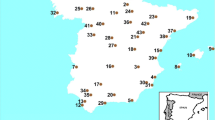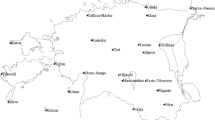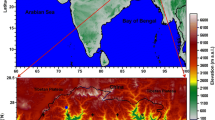Abstract
A set of 17 air temperature and relative humidity sensors were used to analyze the temporal variability of surface air temperature (Tair), wet bulb temperature (Twb), and daily snowmaking hours (SM, number of hours per day with Twb < − 2 °C), lapse rates, and the occurrence of thermal inversions at the Formigal ski resort (Spanish Pyrenees) from December to March during three consecutive ski seasons (2012–2013, 2013–2014, and 2014–2015). The Tair and Twb lapse rates showed strong hourly and daily variability, with both exhibiting almost identical temporal fluctuations.
The Twb exhibited average lapse rates that were slightly steeper (− 5.2 °C/km) than those observed for Tair (− 4.9 °C/km). The less steep lapse rates and most thermal inversions were observed in December. Days having less (more) steep Tair and Twb lapse rates were observed under low (high) wind speeds and high (low) relative humidity and air pressure. The temporal dynamics of the SM lapse rates was more complex, as this involved consideration of the average Tair in the ski resort, in addition to the driving factors of the spatio-temporal variability of Twb. Thus, on a number of cold (warm) days, snowmaking was feasible at all elevations at the ski resort, independently of the slopes of the lapse rates. The SM exhibited an average daily lapse rate of 8.2 h/km, with a progressive trend of increase from December to March.
Weather types over the Iberian Peninsula tightly control the driving factors of the Tair, Twb, and SM lapse rates (wind speed, relative humidity, and Tair), so the slopes of the lapse rates and the frequency of inversions in relation to elevation for the three variables are very dependent on the occurrence of specific weather types. The less steep lapse rates occurred associated with advections from the southeast, although low lapse rates also occurred during advections from the east and south, and under anticyclonic conditions. The steepest Tair and Twb lapse rates were observed during north and northwest advections, while the steepest rates for SM were observed during days of cyclonic circulation and advections from the northeast.








Similar content being viewed by others
References
Allan R, Ansell T (2006) A new globally complete monthly gridded mean sea level pressure dataset (HadSLP2): 1850-2004. J Clim 19:5816–5842
Blandford TR, Humes KS, Harshburger BJ, Moore BC, Walden VP, Ye H (2008) Seasonal and synoptic variations in near-surface air temperature lapse rates in a mountainous basin. J Appl Meteorol Climatol 47(1):249–261
Breiman L, Friedman JH, Olshen RA, Stone CJ (1984) Classification and regression trees. Chapman and hall, New York
Brutsaert W (1998) Land-surface water vapor and sensible heat flux: spatial variability, homogeneity, and measurement scales. Water Resour Res 34(10):2433–2442. https://doi.org/10.1029/98WR01340
Buisan S, Saz MA, López-Moreno JI (2015) Spatial and temporal variability of winter snow and precipitation days in the western and central Spanish Pyrenees. Int J Climatol 35:259–274
Fassnacht SR, Heun CM, López-Moreno JI, Latron J (2010) Variability of snow density measurements in the Esera valley, Pyrenees mountains, Spain. Cuadernos de Investigación Geográfica 36(1):59–72
Frederick JE (2008) Principles of atmospheric Science. Ed. Jones and Bartlett. Massachusets, 199 p
Gardner AS, Sharp MJ, Koerner RM, Labine C, Boon S, Marshall SJ, Burgess DO, Lewis D, Gardner AS, Sharp MJ, Koerner RM, Labine C, Boon S, Marshall SJ, Burgess DO, Lewis D (2009) Near-surface temperature lapse rates over Arctic glaciers and their implications for temperature downscaling. J Clim 22(16):4281–4298
Gilaberte M, Pino MR, López F, López-Moreno JI (2014) Impacts of climate change on ski industry. Environ Sci Policy 44:51–66
Gilaberte M, López-Moreno JI, Morán-Tejeda E, Jerez S, Alonso-González E, López-Martín F, Pino-Otín MR (2017) Assessment of ski condition reliability in the Spanish and Andorran Pyrenees for the second half of the 20th century. Appl Geogr 70:127–142
Goodess CM, Palutikof JP (1998) Development of daily rainfall scenarios for southeast Spain using a circulation—type approach to downscaling. Int J Climatol 18(10):1051–1083
Heynen M, Miles E, Ragettli S, Buri P, Immerzeel W, Pellicciotti F (2016) Air temperature variability in a high-elevation Himalayan catchment. Ann Glaciol 57(71):212–222
Holden J, Rose R (2011) Temperature and surface lapse rate change: a study of the UK’s longest upland instrumental record. Int J Climatol 31(6):907–919
Jenkinson AF, Collison P (1977) An initial climatology of Wales over the North Sea. In synoptic climatology branch Memorandum, 62
Jones PD, Hulme M, Briffa KR (1993) A comparison of Lamb circulation types with an objective classification scheme. Int J Climatol 13(6):655–663
Kattel DB, Yao T, Yang K, Tian L, Yang G, Joswiak D (2013) Temperature lapse rate in complex mountain terrain on the southern slope of the central Himalayas. Theor Appl Climatol 113(3–4):671–682
Kirchner M, Faus-Kessler T, Jakobi G, Leuchner M, Ries L, Scheel H-E, Suppan P (2013) Altitudinal temperature lapse rates in an Alpine valley: trends and the influence of season and weather patterns. Int J Climatol 33(3):539–555
Lasanta T, Laguna M, Vicente-Serrano SM (2007) Do tourism-based ski resorts contribute to the homogeneous development of the mediterranean mountains? A case study in the Central Spanish Pyrenees. Tour Manag 28:1326–1339
Lindberg K, Andersson TD, Dellaert BGC (2001) Tourism development: assessing social gains and losses. Ann Tour Res 28:1010–1030
López-Moreno JI, Vicente-Serrano SM (2007) Atmospheric circulation influence on the interannual variability of snow pack in the Spanish Pyrenees during the second half of the 20th century. Hydrol Res 38(1):33–44
López-Moreno JI, Goyette S, Beniston M (2009) Impact of climate change on snowpack in the Pyrenees: horizontal spatial variability and vertical gradients. J Hydrol 374(3–4):384–396
López-Moreno JI, Pomeroy J, Revuelto J, Vicente-Serrano SM (2013) Response of snow processes to climate change: spatial variability in a small basin in the Spanish Pyrenees. Hydrol Process 27(18):2637–2650
López-Moreno JI, Gascoin S, Herrero J, Sproles EA, Pons M, Hanich L, Boudhar A, Musselman KN, Molotch NP, Sickman J, Pomeroy J (2017) Different sensitivities of snowpack to warming in Mediterranean climate mountain areas. Environ Res Lett 12:074006
Marshall SJ, Sharp MJ, Burgess DO, Anslow FS (2007) Near-surface-temperature lapse rates on the Prince of Wales Icefield, Ellesmere Island, Canada: implications for regional downscaling of temperature. Int J Climatol 27(3):385–398
Minder JR, Mote PW, Lundquist JD (2010) Surface temperature lapse rates over complex terrain: lessons from the Cascade Mountains. J Geophys Res 115(D14):D14122
Molotch NP, Colee MT, Bales RC, Dozier J (2005) Estimating the spatial distribution of snow water equivalent in an alpine basing using binary regression tree models: the impact of digital elevation data and independent variable selection. Hydrol Process 19:1459–1479
Navarro-Serrano FM, López-Moreno JI (2017) Spatio-temporal analysis of snowfall events in the Spanish Pyrenees and their relationship to atmospheric circulation. Cuadernos de Investigación Geográfica/geographical Res Lett 43(1):233–254
Nunez M, Calhoun EA (1986) A note on air temperature lapse rates on Mount Wellington, Tasmania. Pap Proc R Soc Tasm 12012(120):11–15
Pagès M, Miró JR (2010) Determining temperature lapse rates over mountain slopes using vertically weighted regression: a case study from the Pyrenees. Meteorol Appl 17(1):53–63
Pepin N (2001) Lapse rate changes in northern England. Theor Appl Climatol 68:1–2), 1–16
Pepin N, Kidd D (2006) Spatial temperature variation in the Eastern Pyrenees. Weather 61(11):300–310
Pepin NC, Lundquist JD (2008) Temperature trends at high elevations: patterns across the globe. Geophys Res Lett 35:L14701
Pons M, López-Moreno JI, Rosas-Casals M, Jover E (2015) The vulnerability of Pyrenean ski resorts to climate-induced changes in the snowpack. Clim Chang 131(4):591–605. https://doi.org/10.1007/s10584-015-1400-8
Revuelto J, López-Moreno JI, Azorin-Molina C, Vicente-Serrano SM (2014) Topographic control on snowpack distribution in a small catchment in the central Pyrenees: intra- and inter-annual persistence. Cryosphere 8(5):1889–2006
Revuelto J, Azorin-Molina C, Alonso-González E, Sanmiguel-Vallelado A, Navarro-Serrano F, Rico I, López-Moreno JI (2017) In situ observations of meteorological variables and snowpack distribution at the Izas Experimental Catchment (Spanish Pyrenees): the importance of high quality data in sub-alpine ambients. Earth Syst Sci Data 9:993–1005. https://doi.org/10.5194/essd-9-993-2017
Rixen C, Teich M, Lardelli C, Gallati D, Pohl M, Pütz M, Bebi P (2011) Winter tourism and climate change in the Alps: an assessment of resource consumption, snow reliability, and future snowmaking potential source. Mt Res Dev 31(3):229–236
Roland C (2003) Spatial and seasonal variations of air temperature lapse rates in Alpine regions. J Clim 16(7):1032–1046
Scott D, Hall CM, Gössling S (2012) Tourism and climate change: impacts, adaptation and mitigation. Routledge, London
Spandre P, François H, Thibert E, Morin S, George-Marcelpoil E (2017) Determination of snowmaking efficiency on a ski slope from observations and modelling of snowmaking events and seasonal snow accumulation. Cryosphere 11:891–909. https://doi.org/10.5194/tc-11-891-2017
Steiger R, Mayer M (2008) Snowmaking and climate change: future options for snow production in Tyrolean ski resorts. Mt Res Dev 28(3–4):292–298
Stull R (2011) Wet-bulb temperature from relative humidity and air temperature. J Appl Meteorol Climatol 50:2257–2269
Tang ZY, Fang JY (2006) Temperature variation along the northern and southern slopes of Mt. Taibai, China. Agric For Meteorol 139(3–4):200–207
Thayyen RJ, Gergan JT, Dobhal DP (2005) Lapse rate of slope air temperature in a Himalayan catchment—a study from Dingad (Dokriani Glacier) basin, Garhwal Himalaya, India. Bull Glaciol Res 22:19–25
Trigo RM, Dacamara CC (2000) Circulation weather types and their influence on the precipitation regime in Portugal. Int J Climatol 20:1559–1581
Uhlmann B, Goyette S, Beniston M (2009) Sensitivity analysis of snow patterns in Swiss ski resorts to shifts in temperature, precipitation and humidity under conditions of climate change. Int J Climatol 29:1048–1055
Acknowledgements
We thank the ski resort of Formigal for its support in this research.
Funding
This study was funded by the research project CGL2014-52599-P “Estudio del manto de nieve en la montaña española y su respuesta a la variabilidad y cambio climatico” (Ministry of Economy and Development, MINECO).
Author information
Authors and Affiliations
Corresponding author
Rights and permissions
About this article
Cite this article
López-Moreno, J.I., Navarro-Serrano, F., Azorín-Molina, C. et al. Air and wet bulb temperature lapse rates and their impact on snowmaking in a Pyrenean ski resort. Theor Appl Climatol 135, 1361–1373 (2019). https://doi.org/10.1007/s00704-018-2448-y
Received:
Accepted:
Published:
Issue Date:
DOI: https://doi.org/10.1007/s00704-018-2448-y




